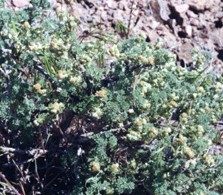Budsage facts for kids
Quick facts for kids Budsage |
|
|---|---|
 |
|
| Arches National Park, Utah | |
| Scientific classification | |
| Genus: |
Artemisia
|
| Species: |
spinescens
|
| Synonyms | |
|
|
The Budsage (Artemisia spinescens) is a cool plant found in North America. It's a type of sagebrush, which belongs to the big sunflower family. Think of it as a cousin to the sunflowers you know!
Sometimes, people used to think Budsage was a different kind of plant called Picrothamnus desertorum. But scientists have done genetic tests and found that it really is part of the Artemisia family.
Where Budsage Grows
Budsage plants are native to the western United States. You can find them in places like southern and eastern California and the Great Basin. They also grow north into Idaho and Montana, and east into western Colorado and northwestern New Mexico.
This plant loves to grow in dry, open areas called scrublands. It prefers soils that have a lot of clay and gravel. Budsage is super tough and can even grow in salty soils! It often shares its home with other plants that like salt, such as saltbushes. It's perfectly suited for very dry climates.
What Budsage Looks Like
Budsage is a small, bushy plant. It usually grows into a round shape, about 30 to 50 centimeters (that's about 1 to 1.5 feet) tall. Its branches start out soft and fuzzy when they are new. But as they get older, they become thorny and rough. The main stem of the plant is woody and has a cork-like feel.
The leaves of the Budsage plant have a strong smell. They are small and fuzzy, and each leaf is divided into thin, pointy parts. Budsage is a deciduous plant. This means it drops its leaves during the hot, dry summer. When it loses its leaves, the plant goes into a resting state called dormancy. It's like taking a long nap until the weather gets better!
The plant's flowers grow in small groups. These groups are called racemes. Each tiny flower group has several small, bell-shaped flowers that don't produce seeds. It also has a few fertile flowers that can make seeds.
After the flowers bloom, the plant produces tiny fruits. These fruits are called achenes. They are less than a millimeter long and have a little bit of hair on them.
How Budsage is Used
Budsage is a good food source for animals, both wild and farm animals. This is especially true early in the growing season. At that time, the leaves are new and soft, making them tasty for animals to eat.
However, as the season goes on, the plant starts to produce a lot of bitter oils. These oils make the plant taste bad. So, animals usually stop eating it later in the year.

